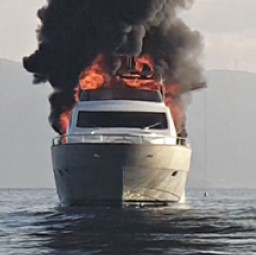The Charity
Aviation
Maritime
M1750

Initial Report
Outline:
CHIRP Maritime received a newly-published flag state investigation report and safety bulletin regarding the above fire with an invitation to promulgate the contents to the wider maritime community.
What the reporter told us:
The vessel concerned was a privately owned leisure vessel (although it had in the past been operated commercially for a short period). The vessel was conducting an international positioning voyage during the winter with only two crew aboard and was close to the coast at the time of the incident.
Shortly after weighing anchor, following an overnight stop, the vessel suffered a catastrophic engine room fire which spread rapidly throughout the vessel.
The two crew abandoned the vessel using a tender and liferaft combination and were unharmed.
The vessel subsequently sank in deep water whilst a firefighting vessel was attempting to extinguish the blaze.
The incident raised some interesting learning points both from things that went well and from those that did not, and these are reflected in the Safety Bulletin.

Figures 1 and 2
The full investigation report and safety bulletin can be read and downloaded at:
https://cdn.ports.je/web/Just-Mine-Incident-report-Nov-20.pdf; and https://cdn.ports.je/web/SB02-of-2021-Lessons-from-a-fire-at-sea.pdf;
CHIRP comment:
The investigation report and the safety bulletin are too extensive to reproduce within the pages of Feedback, however CHIRP Maritime would recommend readers to follow the above hyperlinks and read these two documents which are both interesting and informative and contain learning opportunities for all seafarers.
For any readers without the facilities to access the two documents, the following extracts are taken from the Safety Bulletin.
Although anything mechanical can fail, the risks are reduced when equipment is maintained in accordance with the manufacturer’s guidance.
Check (machinery spaces) frequently and act promptly if anything does not seem to be right.
Effective practice enables right actions to be taken, in the right sequence, at the right time. Although checklists may help, an emergency is not the time to be reading the instruction manuals.
The Golden Rule is ‘Once a space containing a fire is sealed, do NOT reopen it except under the advice of, and preferably with the assistance of, trained firefighters. A significant period is required to allow cooling’.
‘Mayday’ or ‘Pan’? If you need assistance, ask early; it is better to subsequently downgrade a ‘distress’ message to an ‘urgency’ message if the situation improves; than to be unable to send a distress message if it worsens.
Voice or DSC? Both, if possible. The DSC (Digital Selective Calling) function, which would automatically have included a GPS position in the distress message, was not used as it was not user-friendly, not routinely used aboard, and the crew were unfamiliar with its use. Familiarise yourself with your safety equipment. It is better to initiate a call using DSC and back it up with voice communication. Write down your position and update it frequently before making the call so it remains available if your electronics fail.
Hand-held VHFs should be distributed early in an emergency. VHF on channel 16 has the advantage in communicating with all stations in the area and can enable shore stations to obtain your position using DF (Direction Finding) equipment… / …A mobile telephone, preferably waterproofed, can on occasion provide useful backup to VHF, which should remain the primary means of communication.
Lifejackets are useless if not worn. They need to be distributed early in an emergency and must remain readily accessible. They should also be worn whenever there is a risk of falling overboard.
Summary: During this serious incident, the crew reacted quickly and despite the rapid spread of the fire and a couple of mistakes, took the necessary actions to attempt to save first the vessel and then themselves. It is always better to learn from the experiences of others, and it is hoped that all will benefit from the open nature of the crew sharing their experience.
The benefit of hindsight is that it gives the observer 20/20 vision, but what seems obvious to the writer and reader of this article may not have occurred to the two-man crew in the matter of minutes available to them from first detecting the fire to having to abandon the yacht.
The safety bulletin already highlights the “golden rule” about not opening a space containing a fire once it is sealed. Releasing a fire suppression medium like FM-200 into a compartment is the last throw of the dice that will either put out the fire or not – opening the space will only guarantee that it will not.
The fire was detected when the yacht had been under way for only 10 minutes after weighing anchor. That might suggest that there had been an issue in the engine room from the time the engines were started. It would be prudent to have the deckhand in the engine room for the start of the engines and to remain there until the engine systems have reached normal operating temperatures and pressures.
The investigation report lists the yacht’s comprehensive features and equipment for fire protection and fire-fighting. However, an automatic fire/smoke detection system is not listed.
Finally, there is a requirement under IMO for all serious incidents and accidents on commercial ships to be investigated by the vessel’s flag state. There is also a requirement for the findings of the investigation to be presented in a report to the IMO. However, there is no requirement for the findings to be published to the wider maritime community. The Jersey marine accident investigation department has done a very good job in publishing their report, but some flag states do not publish their reports. CHIRP Maritime asks the question, why are all accident investigation reports not put into the public domain and widely publicised to enable all seafarers to learn from the findings?
Report Ends…………………………







